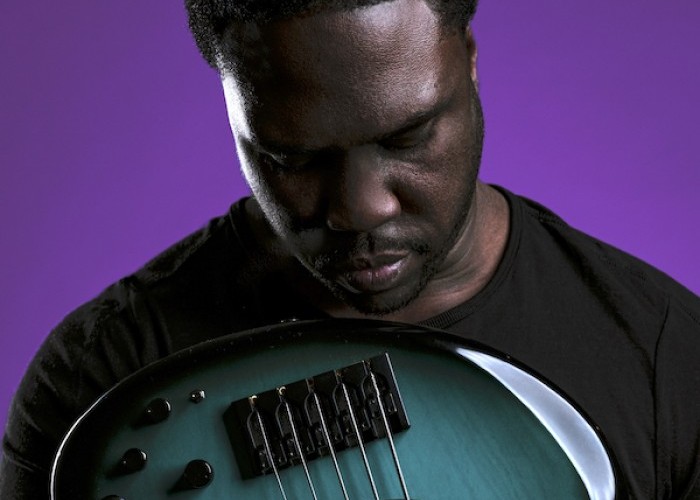Apr 2, 2024 12:59 PM
Saxophonist, Sonic Explorer Casey Benjamin Dies at 45
Casey Benjamin, the alto saxophonist, vocalist, keyboardist and producer who stamped his distinctive sounds on the…

“Color Of Noize is what someone makes of it,” says bassist Derrick Hodge while discussing his new Blue Note release.
(Photo: Ryan Landell)Not long ago, Derrick Hodge had a conversation that forever altered his perspective.
“I had the honor of co-producing Justin Kauflin’s album Coming Home,” Hodge said about the pianist’s 2018 album. “When he first came to me, he said it was because he saw colors when he heard my music. He’s blind, but he saw colors, and that is what drew him to me. ... Suddenly, it could not have been less about what each individual song might have meant to me when I was composing it. For someone else, it meant something that I couldn’t even imagine, and it was absolutely as valid as what I might have been feeling.”
It’s an awareness that every artist comes to sooner or later, but an awareness that generally doesn’t transform how they make art. For Hodge, however, it became an entirely new way of thinking about music. If there was no correct definition of his work, why define it at all? He calls the approach the “color of noize,” which is also the name of Hodge’s new band and his new Blue Note album. If the name seems elusive and indeterminate, that might have been Hodge’s intent.
“What ‘color of noize’ is, officially, is a question mark,” he said. “The more you ask, the more you get no definitive answer. Color Of Noize is what someone makes of it. It’s what the music hopefully means to a person when they hear it—beyond trying to define what it is, what it’s about, what point it’s trying to prove, musically. The point is for people to ask the question, but to come up with their own answers.”
The music, too, refuses to provide easy answers.
Color Of Noize is heavy on atmosphere, with pianist/organist Jahari Stampley, electronic keyboardist Michael Aaberg and turntablist DJ Jahi Sundance blending along with Hodge’s electric bass into hazy washes of sound. But it’s equally heavy on percussion, with dual drummers Mike Mitchell (aka Blaque Dynamite) and Justin Tyson powering nearly every track. Running through the sonic nebulae are recognizable streaks of gospel, funk, hip-hop, r&b, pop and jazz (the last being easiest to discern as the band offers up a cover of Wayne Shorter’s “Fall”).
Hodge, at various points in his career, has been identified with any and all of these genres: His resume includes work with Mulgrew Miller, Terence Blanchard, Jill Scott, Tye Tribbett and Common, among others. Instead of musicians’ frequent urge to resist being put into any of those categories, though, Hodge chooses to be in all of them. That’s also part of the “color of noize” concept.
“Part of that question mark is also the question mark of, ‘Who am I?’” Hodge said. “If people choose to hear me as any one of those things, I’ll take it as an honor that they accept me as an authentic being in whichever tradition that is. But I can’t hold any of it too tight or try too hard to make sure I’m the best version of myself. I wanted to make sure that every part of it was about me letting go and trusting what happens.”
In a sense, that’s another form of resistance: If Hodge belongs to every genre, he belongs to no genre, and anyone who encounters his music will decide what it is for themselves.
Hodge even fogs up the definition of himself as a bassist: At various points on Color Of Noize, he plays upright bass, acoustic guitar, piano, synthesizers and synth bass, and contributes vocals.
The music largely is improvised off Hodge’s basic compositional ideas. Of course, that’s in part due to Hodge’s abiding connection to jazz—but it’s also, in this case, because to compose more fully (as Hodge traditionally has done) would be to provide more definition than he now wants there to be.

Benjamin possessed a fluid, round sound on the alto saxophone, and he was often most recognizable by the layers of electronic effects that he put onto the instrument.
Apr 2, 2024 12:59 PM
Casey Benjamin, the alto saxophonist, vocalist, keyboardist and producer who stamped his distinctive sounds on the…

“He’s constructing intelligent musical sentences that connect seamlessly, which is the most important part of linear playing,” Charles McPherson said of alto saxophonist Sonny Red.
Feb 27, 2024 1:40 PM
“I might not have felt this way 30 to 40 years ago, but I’ve reached a point where I can hear value in what people…

Albert “Tootie” Heath (1935–2024) followed in the tradition of drummer Kenny Clarke, his idol.
Apr 5, 2024 10:28 AM
Albert “Tootie” Heath, a drummer of impeccable taste and time who was the youngest of three jazz-legend brothers…

“Both of us are quite grounded in the craft, the tradition and the harmonic sense,” Rosenwinkel said of his experience playing with Allen. “Yet I felt we shared something mystical as well.”
Mar 12, 2024 11:42 AM
“There are a few musicians you hear where, as somebody once said, the molecules in the room change. Geri was one of…

Larry Goldings’ versatility keeps him in high demand as a leader, collaborator and sideman.
Feb 21, 2024 10:45 AM
Are you having any fun? Larry Goldings certainly is. Consider just two recent examples:
Scene 1: “If anyone had…